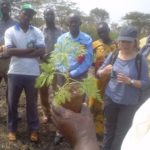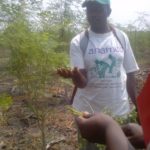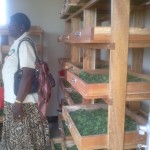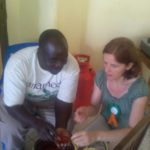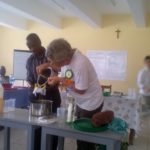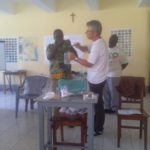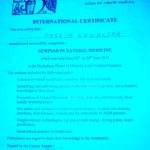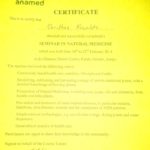Comparition of numbers of artemisia plants required to meet the world demand…
Comparison of the numbers of artemisia plants required to meet the world demand for artemisia a) to provide ACT (Artemisinin Combination Therapies) drugs and b) to provide artemisia tea
Assumption 1: We base the calculation on the experience of growing and harvesting Artemisia annua of a colleague in Brazil: The plants were spaced at intervals of one metre. This corresponds to 10,000 plants per hectare. Under optimal conditions, that gave 45 tons of fresh plants. Of those 45 tons, 15 tons were stems, and a further 27 tons of water were lost in drying. Thus the product was 3 tons of dried leaves per hectare or 300 g per plant. (see Note1) Continue reading
Why this page?
Why this page … Because I’d like to share what I’ve learned in Africa with more people. Traveling through Africa as a volunteer I was afraid of malaria. I spent a long time looking for prevention or effective treatment, without side effects. In a book about Africa that I was reading, I found a name of a plant that cures malaria. So, at that point, I was looking for artemisia annua. And I finally found ANAMED – the first organization in the world to grow this plant for humanitarian purposes in areas affected by malaria. In 2013 in Mwanza ( Tanzania), I participated in a seminar – course organized by Anamed. I took the second course in Nairobi (Kenya) in 2014 where I learned what artemisia annua is, how to cure malaria, how to treat other diseases using tropical plants, and more. Today I’m not afraid of malaria anymore, I drink the infusion of artemisia every day and I prepare myself for the next trip to Africa – to learn more and share what I have already learned with local communities. I invite everybody interested in Africa, malaria, natural medicine and Artemisia Annua Anamed, in short, A-3, to read this page.
Artemisia annua Tea – a revolution in the history of tropical medicine
The golden opportunity that, because of economic and bureaucratic interests, the world is likely to miss.
Each year 300 million people suffer from malaria, and between 1 and 3 million people die of malaria. The rediscovery of the plant Artemisia annua is therefore a matter of joy in the world of tropical medicine. Artemisinin, extracted from the plant, acts 10 to 100 times more quickly than all other known malaria medicines (1).
The key question is, is it necessary to first extract the artemisinin from the dried leaves with an organic solvent, and then to manufacture tablets, or is it possible more simply to grow artemisia and to make tea from the dried leaves? Continue reading
Rich artemisia instead of poor artemisinin!
1. Using artemisia tea has the advantage that each country can produce and use its own anti-malarial with Artemisia annua. Scientific results have shown that the artemisinin content in the blood is high enough after drinking artemisia tea. We quote: “… the minimum concentration required for growth inhibition of P. falciparum can clearly be exceeded with the Artemisia preparations” (Mueller, M.S. et al, Randomized controlled trial of a traditional preparation of Artemisia annua L. in the treatment of Malaria, Transactions of the Royal Society of Tropical Medicine and Hygiene (2004), 98, 318-321). Continue reading

